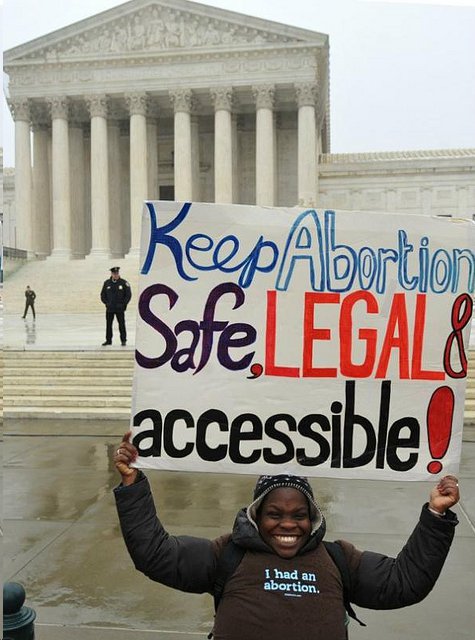The Many Conflicts of the Colorado Personhood Debate

You would have to have a hard soul to hear the story of Heather Surovik and not feel your heart ache, even just a little. At about 4:30 pm on July 5th, 2012, Heather Surovik was eight months pregnant and leaving her final well-baby check-up when Gary Sheats made a sudden, illegal left turn in front of her, giving her no time to stop. The collision that followed was forceful enough to deploy the airbag, which Surovik hit with enough speed to kill her 8-pound fetus, who was to be named Brady Paul Surovik.
At the time of the accident Gary Sheats’ blood alcohol content (BAC) was .292%, more than 3 ½ times the legal limit. In Colorado, a person is considered too drunk to drive if they have a BAC of .08 or higher. But drinking never seemed to stop Sheats from getting behind the wheel. About four months prior to the July 5th accident, the police stopped Sheats for having a cracked windshield and found that he was driving on a revoked license due to previous charges of driving under the influence (DUI) that spanned about three decades. According to court records, Sheats had served less than one year total in jail despite having four prior DUIs and a felony drug offense for the possession of crack-cocaine. And yet he was still on the road.
In the aftermath of the Surovik accident, Gary Sheats faced multiple felony charges of vehicular assault involving a DUI as well as leaving the scene of an accident that caused serious bodily injury. But the DUI charge, which is Sheats’ fifth, remains a misdemeanor and is punishable by between 60 days and a year in jail. This is because in Colorado, unless a drunk driver injures or kills someone, they are merely charged with a misdemeanor regardless of the number of times they have been caught driving under the influence. There is no escalation of punishment. In fact, Colorado is one of only five states without a felony DUI law on the books so, according to House Minority Leader Mark Waller, “you can be convicted of your fourth, fifth, sixth, seventh DUI and get the same penalty every time.” That doesn’t amount to much of a deterrent.
It is understandable that in the aftermath of such a tragic accident Heather Surovik and her family would want some sort form of justice. This seems especially true considering that this accident, and others like it, could potentially have been avoided had Colorado had more severe punishments on the books for people repeatedly pulled over for driving while intoxicated. There was a move back in 2009 to increase punishments for repeat offenders but, citing the high cost of incarceration, the Colorado legislature declined to approve the measure. More recently Representative Waller introduced House Bill 1214 which would “require a motorist be charged with a Class 5 felony for the third incident of driving under the influence in the past seven years or the fourth incident in a lifetime.” Unfortunately, the bill died in the Senate.
Instead of throwing the strength of her story behind a renewed attempt to change the state’s penal code regarding drunk driving, Surovik chose a different route and became the face of Amendment 67 – the so-called Brady Amendment – which sought to redefine the words “person” and “child” in Colorado’s Criminal Code and Wrongful Death Act to include “unborn human beings” as potential victims of violent crime. The initiative is framed as a way to protect “pregnant mothers and their unborn children from criminal offenses and negligent and wrongful acts.” In other words, the passing of this bill, which was ultimately voted down in the November 4th election, would not have impacted Surovik or Sheats retroactively, but would have paved the way for other pregnant women whose fetuses were gravely injured during the commission of a crime.
On the surface, justice for women such as Surovik seems reasonable. After all, Brady was nearly full term and, as far as we know, would have been born healthy and lived a good life had it not been for a serious lapse in Colorado’s handling of DUIs and people like Gary Sheats. But something like the Brady Amendment is potentially much more far-reaching than many advocates let on, at least publicly, in the lead-up to the recent vote. Proponents of the amendment, still smarting from other failed attempts to pass a similar bill in 2008 and 2010, went out of their way to ensure the public that it had nothing to do with limiting access to abortion. Publicly they claimed that the amendment was worded narrowly enough that it would have no impact on abortion whatsoever and was simply a way to protect “pregnant mothers and their unborn children from criminal offenses and negligent and wrongful acts.” But, in an email sent out to supporters who were confused by the wording of the law, Gualberto Garcia Jones, who, along with Heather Surovik, is the “designated representative” of the initiative according to the secretary of state’s website, had this to say:
“Some of our supporters have asked whether the Brady amendment is a personhood amendment. The answer is yes! A personhood measure is any proposal that constitutionally seeks to recognize (without exceptions) that unborn babies are persons deserving of our love and protection by the law….If this suggestion of personhood is established, the case for abortion, of course, collapses, for the fetus’ right to life would then be guaranteed….Whether it is a drunk driver who avoids facing any charges for the death of a baby that is just days from birth, or a hospital that avoids malpractice liability for the death of unborn babies in its care, or an abortionist who kills children in the womb for a living, the fact is that all three rely on the same reasoning: the baby in the womb is not a person and therefore his or her life has no value in the eyes of the law.”

For Brady Amendment advocates such as Jones, the story of Heather Surovik, although tragic, was perfect. A full-term fetus has seemingly nothing in common with a newly fertilized egg and, unlike in the case of the abortion debate, her story is not particularly nuanced. That lack of complexity is exactly what Jones and Personhood USA, the organization for which he works, were relying on. In an email response to Jason Salzman of Reality Check, a news organization that focuses on reproductive and sexual health and justice, Jones said,
“Heather and Brady’s story stands on its own and it is a powerful real-life example of what happens when the preborn are not considered persons. Planned Parenthood is in trouble and they know it, they can talk about fertilized eggs all day long, but they can’t answer the simple question: was Brady Surovik a baby only days from being born a person with basic rights?”
Again, in Heather Surovik’s particular case it is easy to feel moved to say yes, that an essentially full-term fetus that could survive outside the womb should perhaps be treated differently under the law than a newly fertilized egg. But the implications are potentially incredibly far-reaching and rely heavily on the personal beliefs of the particular judge hearing the case.
According to Bigmedia,org, the Rocky Mountain Media Watch Archives, “the vague phrase ‘unborn human beings’ (within the amendment) would be left to the interpretation of a judge. Opponents have pointed out that a judge could rule that all stages of human biological development, from conception on, should be considered ‘unborn human beings,’ thus making personhood the law of the land in Colorado and banning all abortion, even in the case of rape and incest, as well as common forms of birth control.” According to Monica McCafferty, spokesperson for Planned Parenthood of the Rocky Mountains, “questions about when life begins are personal. For some, it’s based on faith, for others it’s a matter of science or medicine. But this isn’t a question that belongs in the state constitution.”
Another interesting layer in this debate is the presence of women, or lack thereof, within the wording of the amendment and, more importantly, in the follow-up email from Jones. The Brady Amendment itself does make mention of protecting women but, placed in conversation with Jones’ email, it seems as though women matter more as the vessel within which the fetus is growing as opposed to human beings who also deserve protection under the law.
In the Surovik case, Heather and her husband planned for a third child and were prepared to care for him. But if this amendment were allowed to play out, and potentially millions of women were denied abortion services or access to Plan B, for example, then the rights of women would necessarily take a backseat to the rights of something that has not even taken a breath of air. In his email to supporters, Jones discusses abortionists who “kill children in the womb for a living” without mentioning that the womb is not a standalone entity but is, in fact, contained within the body of a woman, a body that also has a heart, a brain, feelings, circumstances, and experiences. A woman who knows better what is good for her and what she is capable, or not capable, of providing another human being. And to take this one step further, when a woman’s right to choose is taken away, and she is forced to carry a child to term despite the circumstances surrounding her impregnation and despite her personal and financial realities, you are putting a serious strain on the economic well-being of single women and families as well as on the already overtaxed foster care system.

In the early winter of 2012, The Denver Post did a string of investigative pieces into the state of the child welfare system in Colorado entitled “Failed to Death.” The reality in Colorado is that the state, although it has an overriding interest in the welfare of its citizens, and especially its children, does not have control over the child welfare system. Instead, that control lies with the 64 individual counties, which oftentimes do not report all of the relevant data to the state. In his letter from the editor, Gregory L. Moore reports that between 2007 and 2012, “seventy-two children whose families were known to the system have died,” including nine in 2012 alone.
Much like the criminal code as it relates to drunk driving ultimately failed Heather Surovik and Gary Sheats, the criminal code surrounding abuse is incredibly problematic. According to Moore, when it comes to abused children, “state law itself is less than clear, and prosecutors say it is difficult, if not impossible, to make cases when some children die. Beating or burning a kid is clear abuse, but starving or repeatedly failing to supervise a kid who strays into a street is not part of criminal statues.” The Post then goes on to include the stories, including 911-calls and video, of some of the children who died as a result of the massive cracks in Colorado’s child welfare system.
In the article from December 6, 2012, Jennifer Brown talks about the dire straits of the foster care system in the state of Colorado. As of her writing, there were 4,200 children in foster families who were all split up amongst 2,800 homes. Those 2,800 homes include “kinship parents” – aunts, uncles and grandparents – who normally do not house non-relatives. On top of the 4,200 in foster homes, there are another 800 children and teenagers living in group homes and staff-run residential homes who cannot move to a foster home because there are not enough registered foster homes in the state to accommodate them.
Officials in Colorado estimate that they need between 200 and 280 more foster families in order to accommodate the children and teens who are ready to move out of their current facilities. On top of that, they are looking for families in urban and rural areas so that if kids need to be removed from a home in a hurry, there is a place nearby that is open to them. Furthermore, officials want to keep kids closer to their biological families so that relationships can potentially be mended and the trauma associated with their being placed in foster care can be as minimal as possible. So even if you can potentially get a child out of a dangerous home, there might not be a stable family to place him or her with.
This, of course, is not to say that all women who choose abortion would be unfit mothers or that they would bring their children into unsafe, unstable or unhappy homes. But that possibility does exist. A woman might choose an abortion because she is in an unsafe relationship that she cannot, for many complex reasons, escape from; she might be in college; she might not have a stable income; she might not want children at all and that is her right as well.
The reality is that these debates about personhood always seem to exclude the woman from the conversation and end at the birth of the child, with no acknowledgment of the next 18 years before he or she is legally considered an adult. By getting behind the wheel when he was intoxicated, Gary Sheats made a terribly irresponsible, and irrevocable, decision to put the lives of others in danger and, unfortunately, Heather Surovik and her family had to pay the price in grief. But to support short-sighted legislation that would force a woman to carry to term a child she may not want, or may not be able to raise, is irresponsible in its own right and could potentially put at risk the lives of countless women and children. Any real conversation about family planning, abortion services and contraception need not end at birth, but must continue on to contend with the complications of life.
Author Bio:
Rebekah Frank is a contributing writer at Highbrow Magazine.




























































































































































































































































































































